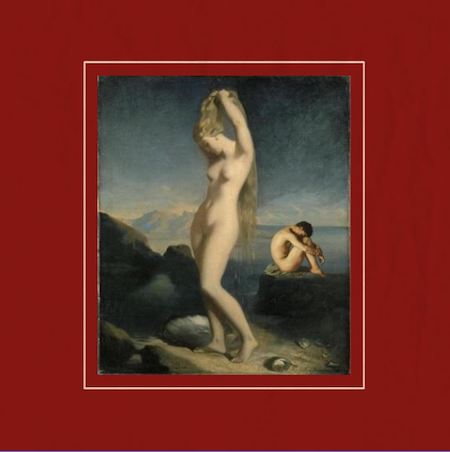
UPCOMING: June 16-22 2025 ~ (Rotterdam, the Netherlands) :: LIVE in WORM :: HAROLD SCHELLINX Post-Post ULTRA (van 1983 tot en dan almaar verdur) :: (it is all) Politics >:> eternity, unPublic, sudoku's, Commuters, 1024, k7, collage, Gentle Slaughter ... Concert on Saturday, June 21. Drinks on Sunday 22!!
SUBSCRIBE to soundblog_un_public our personal / private old-school email newsletter alternative to the use of FB, X, Insta and other surveilling & exploiting media. Our occasional newsletter brings web links to new and not-so-new thoughts, to releases, concert dates, texts related to projects / works by Har$, the ookoi, other collabs, etc.
My « Histoire de l’Art » [Art History] was recently published by the Coherent States label, based in Athens, Greece.
« Histoire de l’Art » received catalogue number CS.44, and is available as a digital download, but also as a carefully crafted and packed CDR.
...
...
(This text is also available at Medium@SoundBlog.)
7 min read 🤓
Art History -)) Histoire de l'Art
july 14, 2022
The official release date is July 14th, 2022. In France that is a national holiday. Bastille Day, the anniversary of the storming of the Bastille two hundred and thirty three years ago, on July 14th 1789. The then there political prison, a symbol of autocratic cruelty, was stormed by (let’s say) the people, and subsequently destructed: it’s what got the French Revolution going.
Nowadays the Place de la Bastille is a vast and dusty roundabout. Not a single stone of the former prison remains. At its very centre rises the so-called July Column, 47 meters high, crowned by a nude golden angel standing on one leg on top of a gilded globe: the “Spirit of Freedom” (Génie de la Liberté). And yes, yes! Our génie indeed makes a fist, he is jumping and crying, he is dancing bizarre…! ( * )
The history of art is a history of repetition.
Like the history of man, like the history of worlds.
The cover of « Histoire de l'Art » is a mash-up that one confined evening was cut-and-pasted together by Chen Yungwei. It combines into a single scene, a scene that makes immediate sense, two paintings by renowned French artists that both were 'children of the revolution'.
The original works are on show side by side in the Salle 940 on the second floor of the Sully wing, in the Louvre in Paris.
Hippolyte Flandrin (1809–1864) made the Jeune homme nu assis au bord de la mer, figure d'étude (Study of a young male nude seated beside de sea) during his residency in Rome, in the years 1835-1836.
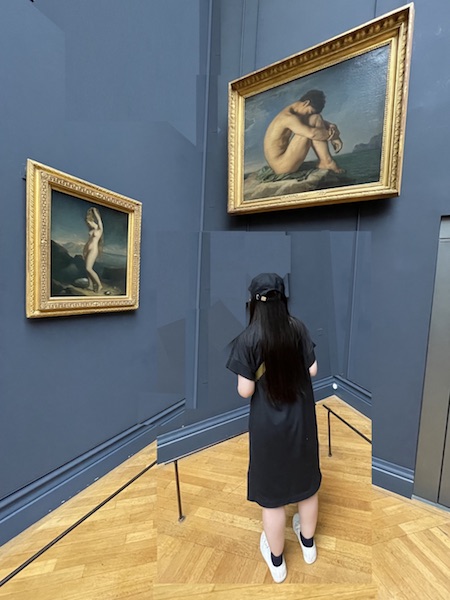
Théodore Chassériau (1819–1856) painted his Vénus Anadyomène just a little later, in 1838. Originating in the descriptions of an antique but lost mural painting by Apelles (4th century BC), the 'Venus of the seas' - the birth of Venus, who emerges from the ocean's foam after the blood and sperm of Ouranos, castrated by his son Kronos, mixed with the sea's salty waters - is a recurring theme in western art, repeated over and over again. Chassérieau's version was presented at the Salon in 1839.
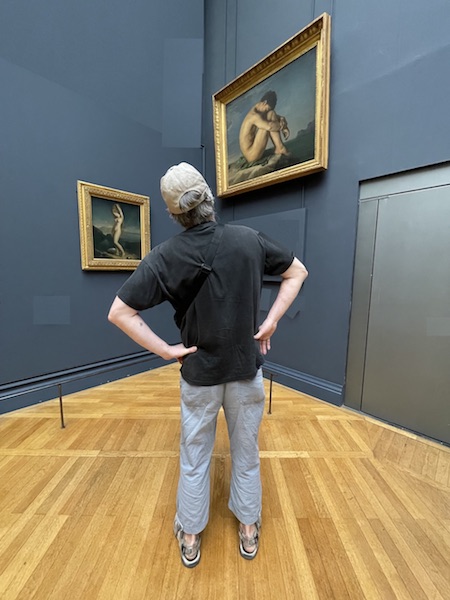
The history of art is a history of repetition.
Like the history of man, like the history of worlds.
In the fall of 2018 Yungwei registered as an undergraduate student in art history at the University Paris I ('Université Paris 1 Panthéon Sorbonne UFR 03' is what it's officially known as). She jumped right into the second year of these undergraduate studies, which in France is called 'Licence 2'. The year after, in 2019, she continued with the 'Licence 3', the third and final undergraduate year, which turned out to be quite an eventful one, due to the corona pandemic that hit France like it did much of the rest of our world at full force about half way through that academic year.
Because French is not her mother tongue, she recorded the many live-lectures she was attending during these four semesters with the dictaphone application on her iPhone, so as to be able to eventually re-listen to, all or parts of, some of them. Many of these lectures took place in auditoriums, where over a hundred undergraduates in art history or archaeology took in the lecturers' words.
During these lectures a substantial fraction of the students present took notes. And almost all of the note-takers were typing their notes, on the keyboards of their laptop computers. The sound of this students' note-taking-typing is of course quite different from the nowadays 'lost' sound that until some decades ago was produced by many an office room full of professional typists hitting their mechanical type writers with great force and at top speed. The typing sounds emanating from the average laptop keyboard is far less intrusive. It brings forth sequences of but soft and modest clicks.
However, all the sounds so made by many, many students typing simultaneously, together makes for a grand choir, a persistent and multi-layered mechanical whisper- and whimpering that will last for almost all of a lecture's duration. And every now and then from background it fades into foreground. That is during the snippets of time in which the lecturer halts her or his speaking, and keeps still.
Yungwei then was so kind as to give me access to her collection of recordings, from which I removed all of the lecturers' words.
What is left in these 'history lectures without the history parts' is this amazing ocean/rain-like sound, as of a thousand electric insects, nibbling and singing in unison, brought forth by many, many laptop keyboards' hi-speed rattling, while capturing the words spoken by the art history lecturer in some or other digital text file. And this typing choir moreover comes interspersed with environmental sounds, of students moving, coughing and sneezing, especially - as you may notice - in those lectures that took place in the early days of the corona pandemic, shortly before confinement and hence before the university's classes moved from physical rooms to virtual zooms.
It is also an audio record that documents an interesting analogue-to-digital data-transfer process: the lecturer speaks words; these combine into phrases, that are heard and understood in some form or other by the students; in their heads they re-combine and most of the time also re-interpret these words; into different phrases and words, the letters of which they then one by one transfer to their laptop's memory by hitting the corresponding keys on their computer keyboard, to save their understanding of the lecturer's teaching as a digital text file.
That is what this album makes you hear.
And as an extra, for some of you, getting into this « Histoire de l'Art » just may come with 'pleasant forms of paresthesia', like 'tingling sensations that start from your scalp, then move down the back of your neck and upper spine', known as auto(nomous) sensory meridian responses (AMSR), that many people also report arising when listening on their balcony in the dark of night to the sizzling rain that continues to fall after a heavy storm, or the murmuring babble of a mountain stream; be it 'real' or be it 'recorded'.
Put the album on random play and endless repeat!
The history of art is a history of repetition.
Like the history of man, like the history of worlds.
...
`AI Postscript
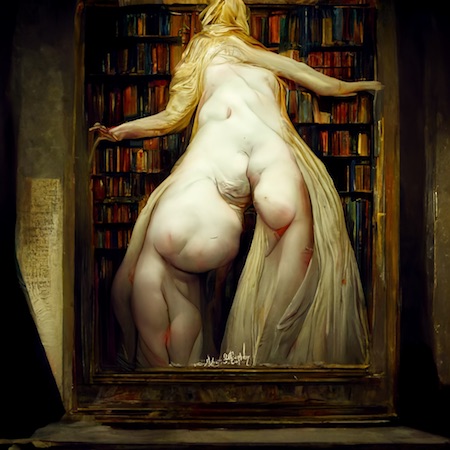
At the same time as preparing this text, I also played around in Discord with the impressive beta of the AI text-to-image generator(s) trained and running now at midjourney.com. The image above is one of four returns that I got from the Midjourney Bot when I entered the '/imagine' command with prompt 'Histoire de l'Art'. This was the one I preferred - as it made sense to me: a bulbous post-Baconian creature passing through a looking glass, where, on the other side, it leans towards a wall lined with books.
That is what meant what I saw.
It's the way the diffusion algorithm's outcome—partly determined by my prompt, but garnished with a fine dose of randomness—fitted me (mine).
Playing around with these AI text-to-image generators feels like passing through a Borgesian gallery filled with all thinkable and makable mixes and mashes of the astronomical number of images in the nets' training sets. Without claiming anything other than a superficial grip on how precisely these neural nets mash and mix the mega-sets of pictures that they were trained on, given the textual prompts they were fed with: it's dazzling combinatorics, and what amazing tools these 'things' promise to be(come)!
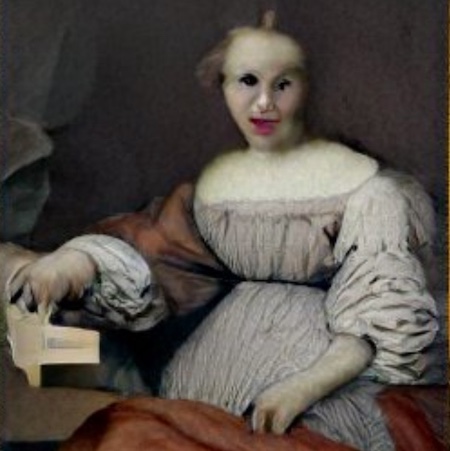
...
For the history of art is a history of repetition.
Like the history of man, like the history of worlds.
...
What others say about Histoire de l'Art
_"The concept is fantastic, and yes, it does transform a lecture hall into a rainforest..." (c.h., 24-8-22)
_"j'ai écouté la musique faite par Harold, je suis tellement touchée ! C'est comme retourner dans la grande salle de cours" (ping, 29-8-22)
_"The album is aural and artistic perfection, and what an awesome genesis story for the recording!" (mvm, 29-8-22)
_"[...] If you have no idea of the origin of these sounds, then I am pretty sure you would have a hard time guessing this. It has, at times, the concept of field recordings, water, for instance, or insects, and it all sounds very lively. Like an amplified nest of ants. There is some variety in the music, but conceptually it all stays close together—a very fascinating listening experience. Schellinx does a beautiful job at editing and cutting these sounds; it must have been very time-consuming, taking the voice out of this material and remaining with such a wealth of sound to work with and create such a great release!" (Vital Weekly 1350, FdW, 30-8-22)"
_"I think it's one of my favorite releases of 2022. conceptually brilliant and very listenable as well." (j.s., 2-9-22)"
_"One of the most unique records in all of the Bandcamp kingdoms. Legend has it that university auditorium recordings were made, then delivered to the artist who removed the voice (like the de-birder algorithm, but with professors). The result is an immersive hush of finger taps, shuffles and breaths, a hushed library of touches, perfectly satisfying. Favorite track: Les Mondes de Degas (Degas’ Worlds)." (m.h., 14-9-22)"
_”I really did enjoy that CD. I put it up on my bookshelf, just to look at it. It’s really brilliant!” (j.n., 24–9–22)
_"Lectures on art history, but without the lectures and without the art history. That is what musician, writer and artist Harold Schellinx has captured on this exceptional album. A student friend of his at the Sorbonne, Chen Yungwei, recorded all her lectures in 2018 so she could listen back to them later at her leisure. Schellinx then made a radical edit of these recordings. Carefully, he cut out all the lecturer's words until only the environmental sounds remained: the zip of a pencil case, the creak of a chair. A cough, a sigh. And above all: the rushing and hushing of hundreds of fingers on the keys of keyboards. It sounds like the tickling of raindrops on dense foliage or the crunch of thousands of insect wings. This is mankind as a swarm, as a colony. Schellinx's method is reminiscent of the adage of New Objectivity: isolate, annex and intensify. By stripping away, he arrives at an essence. Schellinx has captured something elusive: the moment on which students slightly transform the things they are being taught, by selecting, abbreviating, summarising in turn. Art history, Schellinx writes, is a history of repetition. But with each generation of students, with each lecture, something shifts, like an endless play of whispers. You are listening to a piece of congealed time. The subtle differences between the tracks are striking. During a lecture on art institutions, a lonely message tone sounds and during a lecture on cultural heritage, the typing suddenly sounds like the spluttering of oil in a frying pan. What remains constant is a state of shared, supreme concentration, palpable in these recordings. It makes the album not only fascinating but also, as I notice while typing this piece, an extremely meditative soundtrack for writing." (l.f.-j., in Gonzo Circus (Magazine) #172, November-December 2022)"
notes __ ::
(*) Some readers here will have noticed the reference to Maarten Ploeg's lyrics of Interior's ULTRA classic Bizarre Disco, released as a 7 inch vinyl single on the legendary Amsterdam Plurex label, in 1979 (Plurex 0007). [
^ ]
tags: Histoire de l'Art, Art History, AI
# .524.
